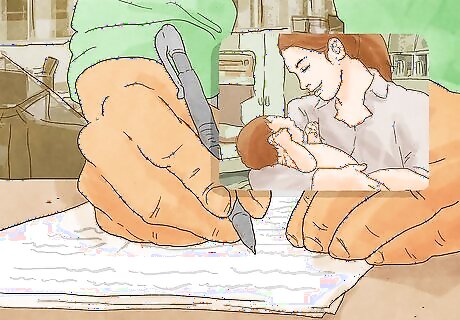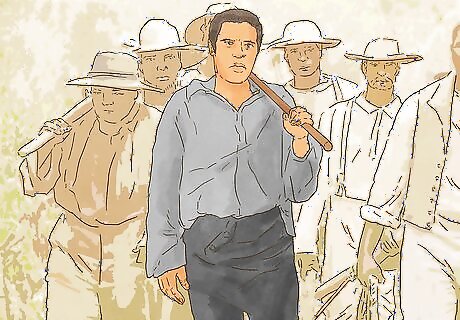
views
Mapping Out Your Life

Write out your life timeline. Start writing your autobiography by conducting research on your own life. Creating a timeline of your life is a good way to make sure you include all the most important dates and events, and it gives you a structure to build upon. You can consider this the "brainstorming" phase, so don't hesitate to write down everything you can remember, even if you don't think the memory will make it into the final version of the book. Your autobiography doesn't have to begin with your birth. You may want to include some family history as well. Write down information about your ancestry, your grandparents' lives, your parents' lives, and so on. Having information about your family history will help readers get a sense of how you became the person you are. What happened when you were a teenager? What led you to make the decisions you made? Did you go to college? Write about those transitory years, too. Write about your career, your relationships, your children, and any big life-altering events that occurred.

Identify the main characters. Every good story has interesting characters, friends and foes who help move the plot along. Who are the characters in your life? It's a given that your parents will play a role, along with your spouse and other close family members. Think beyond your immediate family to others who have affected your life and should play a role in your autobiography. Teachers, coaches, mentors, and bosses are extremely influential in people's lives. Decide whether someone who has been a role model (or the opposite) for you will figure into your story. Ex-boyfriends and girlfriends might co-star in some interesting stories. What enemies have you had in life? Your story will be boring if you don't include some conflicts. Offbeat characters such as animals, celebrities you've never met, and even cities are often points of interest in an autobiography.

Pull out the best stories. The story of your entire life would start to get pretty long-winded, so you'll have to make some decisions about what anecdotes you're going to include. Begin drafting your manuscript by writing out the main stories that will be woven together to create a picture of your life. There are a few main topics that most autobiographies cover since readers find them fascinating. The childhood story. Whether your childhood was happy or traumatic, you should include a few anecdotes that give a picture of who you were and what you experienced at the time. You can tell the story of your childhood by breaking it down into smaller anecdotes that illustrate your personality - your parents' reaction when you brought home a stray dog, the time you climbed out of the window at school and ran away for 3 days, your friendly relationship with a homeless person living in the woods… get creative. The coming of age story. This heady and often sensual period in a human's life is always of interest to readers. Remember that it's not about writing something unique; everyone comes of age. It's about writing something that resonates with readers. The falling in love story. You could also write the opposite of this, the never-finding-love story. The identity crisis story. This usually occurs in the 30s or 40s and is sometimes referred to as a mid-life crisis. The story of facing down some force of evil. Whether it's your battle with addiction, a controlling lover, or a madman who tried to kill your family, you've got to write about conflict you've experienced.

Write in your own voice. People read autobiographies to gain insight on what it's like to be someone else. Being authentically you is a sure way to keep people engaged. If your writing is formal and stiff, or if it reads like a college essay instead of an expose on your life, people will have trouble getting through the book. Write as though you're opening your heart to a trusted friend, in prose that's clear, strong and not too cluttered with vocabulary words you rarely use. Write so that your personality is revealed. Are you funny? Intense? Spiritual? Dramatic? Don't hold back; your personality should come through in the way you tell your story.

Be revealing. You don't have to be explicit, but it's important to reveal truths about yourself and your life in an autobiography. Don't let the book become a list of your accomplishments, with all the negative material carefully kept under the rug. Present yourself as a whole person, sharing talents and flaws alike, and your readers will be able to identify with you and hopefully root for you as they make their way through your story. Don't always cast yourself in a positive light. You can have foibles and still be the protagonist. Reveal mistakes you've made and times when you've failed yourself and other people. Reveal your inner thoughts. Share your opinions and ideas, including those that may spark controversy. Be true to yourself through your autobiography.

Capture the spirit of the times. How was your story shaped by the moment in history in which it took place? What wars influenced your politics? What cultural events inspired you? Be sure to include a few important dates so readers can understand the sequencing of the events you are describing. Discussing what happened in the world at large during your lifetime is a good way to make your story more relevant and interesting to those reading it.
Crafting a Narrative

Create an overarching plot. Now that you know what content you want to include in your autobiography, think about how you want to structure your book. Like any great book, your autobiography needs a great plot. Work with the material you have to craft an interesting story that builds toward a climax and ultimately resolves. Create a narrative arc by organizing and filling out your written memories and anecdotes so that they flow together logically. What's your central conflict? What's the biggest obstacle life presented that took years to overcome or come to terms with? Maybe it's an illness you were diagnosed with at an early age, a relationship wrought with turmoil, a series of career setbacks, a goal you worked for decades to achieve, or any other number of things. Look to your favorite books and movies for more examples of conflicts. Build tension and suspense. Structure the narrative so that you have a series of stories leading up to the climax of the conflict. If your central conflict is trying to reach the goal of competing in the Olympics for skiing, lead up to it with stories of small successes and plenty of failures. You want your readers to ask, will she make it? Can he do it? What's going to happen next? Have a climax. You'll get to the point in your story when it's time for the conflict to come to a head. The day of the big competition has arrived, a showdown happens with your worst enemy, your gambling habit gets the better of you and you lose all your money - you get the picture. End with a resolution. Most autobiographies have happy endings because the person writing the story lived to tell the tale - and hopefully get it published. Even if your ending isn't cheerful, it should be deeply satisfying. You somehow accomplished your goal or won the day. Even if you lost, you came to terms with it and gained wisdom.

Decide where the story is going to start. You could do a straightforward chronology of your life, beginning with your birth and ending in the present, but mixing up the chronology can make the story more interesting. You could frame the entire autobiography with reflections from the present, telling your story through a series of flashbacks. You could begin the story with a poignant moment from your childhood, go backward to tell the story of your heritage, move forward to your college years, and launch into the story of your career, with anecdotes from your childhood sprinkled in for comic relief.

Weave in themes. Use the major themes of your life as a way to tie stories together, connecting your past and your present. Aside from the central conflict, what themes have followed you throughout your life? A fondness for certain holidays, your fascination with a certain place that you visited over and over, a certain type of guy you've always fallen for, a rich spiritual life you fall back on again and again. Bring up the themes every so often to help form a cohesive picture of your life.

Take a step back to reflect. You're chronicling your life lessons, but what have you learned from them? Relay your intentions, desires, feelings of loss, feelings of joy, the wisdom you've gained, and other inner thoughts from time to time throughout the book. Taking a step back from the action of the story to reflect on what it all means is a good way to add depth to your autobiography.

Use chapter divisions to give the book structure. Chapters are useful because they allow you to move on from discussing certain life periods or events. There's a reason we have the expression that we've "closed a chapter" or "opened a new chapter" in life, and it's even more applicable when discussing an autobiography. Chapter breaks allow you to skip forward 10 years, go back in time, or start describing a new theme without jarring the reader too much. Consider ending chapters on a poignant or suspenseful note, so people can't wait to start the next one. The beginnings of chapters are a good place to take a bird's eye view of your past, describe the setting of a place, and set the tone for what's to come.
Editing the Book

Make sure you get the facts right. Double check dates, names, descriptions of events, and other items you're including in your book to make sure you've gotten all the facts down correctly. Even though you're writing the story of your own life, you shouldn't publish incorrect information about what occurred. You can stretch the truth about your own goals and intentions, but don't include fabricated conversations with real people, or altered versions of events that really happened. Of course, you won't remember everything perfectly, but you should reflect reality as best you can. Get permission to use people's names or quote them if you're including content on what other people said or did. Some people don't appreciate appearing as a character in someone else's autobiography, and you should respect that by altering the way you describe them or changing their names if necessary.

Edit your draft. Once you've finished your first draft, go back through it with a fine-toothed comb. Reorganize passages, paragraphs and even chapters where necessary. Replace mundane words and make your phrasing more interesting and clear. Correct your spelling and grammar.

Share it with other people. Present your autobiography to your reading club or a friend so you can get an outside opinion. Stories you find impossibly funny might seem dull to someone else. Get feedback from several people if you can, so you'll have a better idea of how your book comes across to other people. If several people recommend cutting a certain section, strongly consider making the cut. Try to get opinions from people outside your circle of family and friends. People who know you might try to spare your feelings, or they might be biased - especially if they appear in the story.

Hire a copyeditor. A good copy editor will clean up your writing and make the dull parts shine. Whether you're planning on getting your book published at a publishing house or going the self-publishing route, it's never a bad idea to have a professional polish your book at the end of the writing process.

Come up with a title. It should match the tone and style of your book, in addition to being attention-grabbing and intriguing. Keep the title short and memorable, rather than wordy and difficult to grasp. You could title it with your name and the words "My Autobiography" or choose something less direct. Here are some famous autobiography titles that perfectly capture the stories inside: Bossy Pants, by Tina Fey. My Confession, by Leo Tolstoy. A Long Walk to Freedom, by Nelson Mandela. The Sound of Laughter, by Peter Kay.
Publishing Your Story

Take steps to self-publish your book. Even if you don't want to worry about trying to sell your book to the public, you might want to have it designed and printed to keep for yourself and give to your family members and other people featured in the book. Research companies that offer book designing, printing, and shipping services, and decide how many copies you'd like to order. Many companies offering these services produce books that look just as professional as those printed by traditional publishing houses. If you don't want to pay for a publishing service, you can still create a nice copy of your book by taking it to a copy store and having it printed and bound.

Consider finding a literary agent. If you want to publish your autobiography and share it with the world, enlisting the help of a literary agent can get you on your way. Research agents that work with autobiographies and send them a query letter with information about your book, yourself, and how you think the book should be marketed. Start the query letter with an airtight blurb succinctly describing the highlights of the book. Situate your book in the correct genre, and describe what will make it stand out from the rest. Tell the agent why you think he or she is the right person to shop your book around to publishers. Send sample chapters to agents who show interest. Sign a contract with an agent you trust. Make sure to read the contract carefully and check into the agent's history before signing anything.

Submit a query letter directly to publishers. If you don't want to take the time to find an agent, you can submit a letter directly to publishers and see if anyone bites. Research publishers that publish books in the same genre. Don't send the entire manuscript right away; wait until you get a manuscript request from the publisher. Many publishers don't accept unsolicited manuscripts or queries. Make sure you only send letters to publishers that accept them. If a publisher decides to move forward with a book deal with you, you'll need to sign a contract and set up a schedule for editing, designing, proofreading, and finally publishing the book.

Look into publishing your book online. This is an increasingly popular method for publishing books, and a great way to save on printing and shipping expenses for all involved. Research online publishers that publish the books in the same genre, submit your query letter, and move forward with editing and publishing the text.




















Comments
0 comment